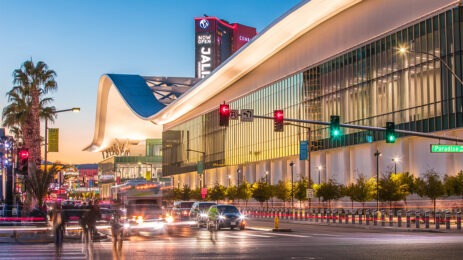With the acquisition of digital event platform Run The World, EventMobi wants the industry to know that virtual events are a more powerful tool than we realize.
“There were a few things that were revolutionary in terms of virtual events during the pandemic, first of all because we couldn’t go anywhere. We had no choice,” says Bob Vaez, founder and CEO of event software platform EventMobi, speaking about the turn to virtual events and meetings during the height of the Covid-19 pandemic. “The technology adoption was extraordinary.”
Smart Meetings sat down with Vaez to assess the role of digital events in light of EventMobi’s recent acquisition of the groundbreaking virtual events platform, Run the World, as well as the swift return to in-person events following the pandemic.
Since its founding in 2010, EventMobi has expanded its reach to over 30,000 corporate and non-profit event planners. Its full suite of event management tools includes event registration and check-in, advanced analytics, mobile event apps, customizable branding and design, engagement and networking tools and more.
Run the World was founded in 2019 and was massively adopted early on. They have since then hosted nearly 50,000 events. EventMobi hopes to build on Run the World’s powerful branding and network as they put forth an innovative new understanding of how companies can strategically move between in-person, virtual and hybrid events to meet their greatest potential.
Read More: The Future is Hybrid-ish
Reimagining What Virtual Events Can Be
Vaez is clear: “Virtual events do not replace in-person events.” They simply can’t provide the same experience. “It’s really hard to try to record a gala ceremony and get people to watch that online,” he explains. “Whereas, when you have content specifically created for remote audiences, you can repurpose your message, which makes it easier to get people to view that content later on.”
Rather than create live hybrid content, so that remote guests can view the same content that in-person guests are experiencing, Vaez emphasizes the impact of digital-first content.
Put forward the same content, but do so with a focus on creating a digital experience. “The core of virtual events is to create live content. Since the pandemic, live content has evolved,” says Vaez.
The most successful virtual events use a platform that allows users to view TV-quality content. It features transitions, well-rehearsed speakers and is short enough to keep people engaged. This digital content is created in an advanced live-streaming studio, and its goal is focused on creating an engaging live-streaming experience—not on recording an in-person experience.
“The technology hasn’t really changed that much. What has changed is the experience that event planners are creating virtually.” Vaez made the point that attendees in a virtual event are in a very different state of mind than attendees at an in-person event—the programs need to be built to that virtual state of mind.
How Virtual Events Can Build Community 365 Days of the Year
Vaez explains that virtual events and in-person events don’t have to exist in separate spheres either. We can offer a continuous hybridized event format that helps maintain engagement 365 days of the year.
A major question always on the mind of the meetings industry is, “How do you maintain engagement once the event ends?” With virtual events, says Vaez, “you can continue meeting, maybe in smaller groups or with more specific topics, and bring groups of attendees back, engage with experts throughout the year. Use that to retain your audience, and hopefully, bring your audience back next year.”
“This is a great shift in the industry, to move away from transactional annual events into year-round experiences,” says Vaez.
Read More: State of Virtual Meeting Tools
Attendees gather in an event space and meet sponsors, speakers and network with their community. After the event, they spend time on the event platform, share their own event content and continue to network there; they’re still engaged. This is where you can see what content attendees are engaging with most and what they may want to see more of. Use that to build a virtual experience.
“An attendee puts in a significant amount of time and energy to get to an event. Having that continuity is a really strong retention mechanism. When you ask them to register again for next year’s event, they haven’t forgotten about it, because they’ve had this continuous experience.”
The Many Benefits of Virtual Events
Virtual events offer several benefits you just can’t get with in-person events. Firstly, virtual events cost significantly less money and take far less time to organize. “If your company is launching a product in six weeks, there’s no way you can prepare a massive in-person event. But you can do that virtually.” Additionally, the investment you put towards virtual events that build on an in-person event pay off enormously in the continuity of attendee engagement.
“Virtual events allow you to extend the reach of your content,” says Vaez. They provide essential access for attendees who have a disability or live far away. The company has its pick of speakers, as well. “It’s less expensive and more likely to find any speaker from anywhere in the world that can go to your virtual event, but difficult to get the right speakers to your location for your in-person events.”
And although we tend to think of networking as a strictly in-person experience, continuous virtual events can actually serve as a great tool for building really solid networks. Two professionals can meet at an event and spend 15 minutes chatting, add each other on LinkedIn, and never speak again. Or they can meet again at a virtual event—there, they’re far more likely to continue the conversation.
“Virtual on its own is really hard to get off the ground, especially post-pandemic, but works phenomenally well as part of an engagement strategy following an in-person event.”
Read More: 7 Tips for Driving Attendee Engagement at Virtual Events
The Future of Virtual Events
EventMobi envisions a new future for virtual events, not merely as a way to extend reach or make the content of an in-person event more accessible, though they do these things well. Virtual events are a powerhouse of their own, and an incredibly useful tool when planners invest in producing high-quality virtual content and pay attention to the distinct way people interact in an event as a virtual audience.
Virtual events, when used in conjunction with in-person events, establish a solid network of attendees who remain in-the-know about your business and the part they play in it. They do not only get involved and engaged at one in-person event; they remain involved and engaged.




